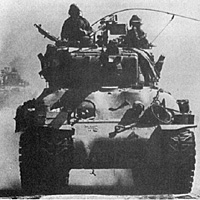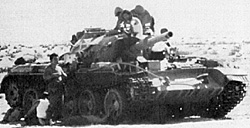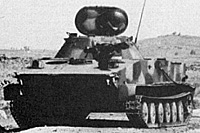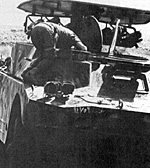 Few wars have come to be known by as many names as
the 1973 Arab-Israeli War. Commonly known in the West as the Yom
Kippur or October War, the conflict is sometimes called The War of
Atonement in Israel and the Ramadan War in the Arab world. Along
with the numerous names for the conflict, this war is significant for
the extremely varied types of equipment used by the belligerents. The
Arab armies were predominantly supplied with equipment furnished by the Soviet Union.
Few wars have come to be known by as many names as
the 1973 Arab-Israeli War. Commonly known in the West as the Yom
Kippur or October War, the conflict is sometimes called The War of
Atonement in Israel and the Ramadan War in the Arab world. Along
with the numerous names for the conflict, this war is significant for
the extremely varied types of equipment used by the belligerents. The
Arab armies were predominantly supplied with equipment furnished by the Soviet Union.
The Israeli Defense Forces on the other hand used a mixture of American, British, French, and captured Soviet equipment. This article relates the equipment used by these armies to the Yom Kippur counter mix.
Armor
The Egyptian army held 2,200 Main Battle Tanks (MBT) at the opening of the war; the majority of these were T-54/T- 55 series tanks (for the remainder of the article I will refer to the series as the T-55 for simplicity), with the balance being mainly T- 62As plus some ancient T-10, T-34/85, and T-34/100 tanks. The PLO Ain Jalloud Brigade had a battalion of T-34/85s attached (see Table 1).
| Table 1 | |
|---|---|
| T-54/T-55 | 1,250 |
| T-62As | 400 |
| T-10, T-34/85, and T-34/100 | 550 |
| Total | 2,200 |
The T-55 tanks were used to arm the armored components of the infantry and mechanized divisions. The T-55's primary armament was a 100mm rifled cannon, and the vehicle's secondary armament consisted of two 7.62mm machine guns. This MBT was powered by a diesel engine which generated 580 Hp, and the T-55 series weighed only 39.7 tons, as compared with an average of 54 tons for the Israeli Defense Force's (or IDF) western tanks. This smaller weight was achieved at the cost of a very cramped crew compartment and the storage of only 43 rounds of ammunition. Additionally, the gun barrel was only capable of depressing to -4 degrees. This limitation, combined with the vehicle's smaller profile, hindered the tank's ability to use hull down shielding.
The T-62A was the next generation in Soviet tank evolution. The Egyptians used this tank to equip the independent armored brigades and the armored divisions. The primary armament consisted of a 115mm smoothbore gun, with a 7.62mm machine gun as the secondary armament. A 12.7mm machine gun was added for anti-aircraft protection. The MBT was powered by a 572 Hp diesel engine and weighed 41.3 tons. The small size of the T-62A also held all of the disadvantages the T-55 series, with only 40 rounds of ammunition carried and a gun barrel depression of -4 degrees.
All in all the Soviet armor's performance was mediocre at best, and inherent disadvantages limited the Egyptian MBTs' effectiveness. In addition to the previously mentioned lack of ammunition and gun barrel depression, the confined spaces of the crew compartment and a lack of air conditioning quickly lead to crew fatigue.
The driving controls of the tanks were primitive and required considerable strength (and sometimes a mallet) to handle. A clumsy fire control system allowed only 3-5 rounds per minute to be fired, as compared with 8-10 rounds per minute for the IDF. Additionally, Soviet armor's gun ranges were about half that of the IDF's, and in the open spaces of a desert shoot-out, he who shoots first lives longest Oust ask any Iraqi tanker you may meet). Even in the hands of the bravest of men, the Arab tanks left their crews at a severe disadvantage. This is just one of the many reasons why an IDF battalion-sized Task Force almost equals a full Egyptian Brigade in strength in Yom Kippur.
 The IDF's primary MBTs consisted of the
American-produced M48A3 and M60A1 as well as the British
Centurion Mk5. Additionally, extensive numbers of refurbished
Sherman tanks (M50s and M51 Ishermans) plus a few captured and
modified T-55s designated the TI-67 (or Tiran) filled some of the
reserve ranks of the IDF. A designer of the original vehicles would
find little in common with most of the IDF vehicles. The Israeli
engineers quickly modified most of the equipment they received;
indeed, during Yom Kippur the Centurion was said to have around
2,000 modifications (with many more today, including add-on Blazer
Armor). The IDF held approximately 2,200 MBTs on October 6th;
exact numbers are hard to come by (see Table 2).
The IDF's primary MBTs consisted of the
American-produced M48A3 and M60A1 as well as the British
Centurion Mk5. Additionally, extensive numbers of refurbished
Sherman tanks (M50s and M51 Ishermans) plus a few captured and
modified T-55s designated the TI-67 (or Tiran) filled some of the
reserve ranks of the IDF. A designer of the original vehicles would
find little in common with most of the IDF vehicles. The Israeli
engineers quickly modified most of the equipment they received;
indeed, during Yom Kippur the Centurion was said to have around
2,000 modifications (with many more today, including add-on Blazer
Armor). The IDF held approximately 2,200 MBTs on October 6th;
exact numbers are hard to come by (see Table 2).
| Table 2 | |
|---|---|
| Centurions | 1,000 |
| N148s | 650 |
| M60s | 400 |
| Tirans | 150 |
| Total | 2,200 |
All three of the IDF's primary tanks were armed with either a British-designed L7 105mm rifled gun or a derivation of this weapon. Also, the power plants and transmissions of these MBTs have been considerably upgraded. The American vehicles held 62 and 63 rounds respectively in the M48 and M60 series, while the Centurion could hold up to 70 rounds (a significant increase over the Arab armor). While the M48 could depress its barrel only to minus 4 degrees, the M60 and Centurion could depress their barrels up to minus 10 degrees. This capability, combined with the higher profiles for all of the vehicles, allowed IDF crews to take maximum advantage of the terrain features of the Sinai desert. The Israeli-modified Centurion is sometimes referred to as the Ben Gurion (and in Avalon Hill's The Arab-Israeli Wars as the Patturion; I have never found reference to it as such in any other source and would be quite interested to know where that designation came from).
The Sherman tanks have a fascinating history. Many were salvaged in the early 1950s from dumps in Italy and the Philippines. When the French began to experience troubles in Algeria, they looked more favorably toward Israel and began to supply the IDF with M1 SuperShermans mounting a 76.2mm. gun. In 1954, the French offered the IDF a new high velocity 75mm gun which held a greater penetration capability. The Israelis and the French began to work on fitting the French CN 75-50 gun and a new counter-balanced turret to the IDF vehicles. After much trial and error, the M50 Sherman tank was born. Following the 1956 Sinai campaign, the IDF decided to upgrade the gun to a French 105mm gun and the engine to a 460 Hp Cummins diesel engine in addition to a myriad of other modifications.
 A World War II veteran would have great difficulty finding his way
around this modified vehicle, with only the most basic shape being
similar to the original Sherman. In addition, the Sherman chassis has
been used for numerous other variants including the M50 and L33 self-propelled artillery pieces and the 160mm self-propelled mortars (which will be discussed in a later article).
A World War II veteran would have great difficulty finding his way
around this modified vehicle, with only the most basic shape being
similar to the original Sherman. In addition, the Sherman chassis has
been used for numerous other variants including the M50 and L33 self-propelled artillery pieces and the 160mm self-propelled mortars (which will be discussed in a later article).
The TI-67s were captured T-55 tanks which the IDF modified by adding the L7 105mm gun, a fire control system, air conditioning, and an American diesel engine. Although the IDF considerably improved these vehicles, they remained one of the least favorable postings in the Armored Corps. The Gonen armored brigade was armed with this tank and commanded by Yoel Gonen, the brother of the Southern Command commander. The other brigades are a mix of the other types of vehicles. All performed almost equally during the war and were virtually indistinguishable.
Infantry
The most important weapon the Egyptian infantryman brandished would prove to be the antitank missile. Egyptian infantry divisions were heavily reinforced with antitank munitions when they crossed the canal on the 6th. These weapons would prove to be the shield upon which the initial IDF armored strikes were blunted. Each infantry unit had specially created antitank hunter-killer teams armed with RPG-7 and Sagger antitank missiles.
Each team had drilled dozens, and in some cases hundreds, of times in crossing a water barrier and then quickly sprinting to preplanned ambush positions. Special backpacks were devised to allow these troops to carry extra antitank rounds on their backs during the crossing. When the inevitable (and unprotected) Israeli armored counterattacks approached the canal, these teams sprung into action, swarming the startled tankers and destroying numerous IDF tanks in the first three days of the war.
After the battles on the 8th, the IDF recovered and began to form combined arms teams designed to deal with the antitank missile threat. Each IDF battalion-sized task force had a mechanized infantry company attached to it. The Israelis quickly learned to watch for the flash of a Sagger launch and then pepper the area of the launch with 50 cal. machine gun fire. This suppressive fire caused the operator to break his optical lock on the target and the missile to veer off course.
The high level of antitank weapons made available to the front-line Egyptian infantry divisions was achieved by stripping reserve formations of most of their antitank weapons. This strategy would later have dire consequences when the IDF crossed the canal, as many reserve troops had no means to combat the IDF armor and were overrun.
The Egyptian commando battalions that were helicoptered into the Sinai achieved mixed results. They never succeeded in blocking IDF reinforcement routes; however, they did result in IDF search and destroy missions and a general unease among the Israeli troopers far out of proportion to their actual value.
Most Egyptian infantrymen/rangers were armed with the ubiquitous AK-47 assault rifle, which performed well in combat. Mechanized infantry units were armed with BTR-50, BTR-60, and BMP armored personnel carriers (APCs). Also, BRDM-2 Saggerequipped scout cars were provided to increase the level of antitank protection for infantry units.
Israeli infantry units were armed with the American M- 16 assault rifle and Israeli Uzi submachine gun. Antitank protection was largely provided by jeep-mounted 106mm recoilless rifles and, late in the war, American-provided TOW antitank missiles. The issue as to just when the IDF received this weapon is still debated. The Egyptians claim the TOW was used against them during the battles of the 14th, and the IDF claims that these weapons were not used at all during the war. (I tend to believe the Egyptian claims that the TOWs were used during the conflict, probably on the 14th or during the crossing on the 15th. Given the light weight of this weapon, the extensive American airlift operation, and the great shock the IDF suffered at the hands of Soviet-built antitank missiles, I find it hard to believe that the Americans would have held back this weapon until after the IDF had secured victory on the battlefield.)
Over all, the paratroopers tended to be more elite forces, while the general infantry and mechanized infantry were largely reservists and had been neglected by the IDF in favor of the armored forces. Mechanized infantry units used World War II vintage M-3 halftracks and some M-113 APCs, called the Zelda by the IDF troopers. The roof of the M-113 quickly proved of value to the Israelis -ry barrages. as it lent a bit of protection from shrapnel during artille
Generally, the IDF should have held the advantage in infantry over the Egyptians, given the amount of money spent by the Israelis per man. This did not prove to be the case, as both sides fought well throughout the conflict but the Egyptians tended to hold the edge in leadership and proficiency. There are may cases where the Egyptian infantry fought tenaciously and sometimes to the last man. Many of the smaller Israeli infantry formations were either scratch units or elite reconnaissance units named after the commanding officer or in some cases nuts (yes, nuts).
Reconnaissance Units
 Egyptian reconnaissance (recon) units tended to be
organized along Soviet lines, with one battalion per armored and
mechanized division. The recon units were supplied with Soviet
equipment, with BRDM- 1/2 scout cars and PT-76s generally
comprising most of the equipment. I include the Egyptian 130th
Marine Brigade in the recon units group, as it was equipped along
reconnaissance unit lines. The brigade was composed of 2
battalions with 20 PT-76B amphibious tanks, 74 BTR-50 APCs
and 18 BRDM-2 scout cars (equipment list provided by Mr.
Joseph Bermudez).
Egyptian reconnaissance (recon) units tended to be
organized along Soviet lines, with one battalion per armored and
mechanized division. The recon units were supplied with Soviet
equipment, with BRDM- 1/2 scout cars and PT-76s generally
comprising most of the equipment. I include the Egyptian 130th
Marine Brigade in the recon units group, as it was equipped along
reconnaissance unit lines. The brigade was composed of 2
battalions with 20 PT-76B amphibious tanks, 74 BTR-50 APCs
and 18 BRDM-2 scout cars (equipment list provided by Mr.
Joseph Bermudez).
Israeli reconnaissance units tended to be a lot more varied in organization and equipment. Each armored and mechanized brigade had a recon company assigned (incorporated into the Task Forces in the game). The recon companies had 20 tanks/APCs assigned for armored brigades, and were generally made up of jeeps and APCs for the mechanized brigades.
Each division had a reconnaissance battalion attached which was equipped with jeeps, White scout cars, AMX-13s, some main battle tanks and APCs. The same is generally true for the Ivan recon battalion. The Ha Sinai (HaSini) recon battalion, on the other hand, is a fascinating unit. Ha Sinai (I got this designation form Mr. Bermudez, who extended a great deal of help during the research for the game) was the elite Southern Command recon unit and was equipped with captured Soviet equipment.
The battalion held PT-76s and BTR-50s in its inventory; the idea behind the unit was for it to use the enemy's equipment to infiltrate the front lines and wreak havoc in its wake. This unit apparently played a large role in leading the attack on the night of the 14th-15th in the Chinese Farm area.
[Ed. note: Hmmmm, could this be justification to apply the ZOC-infiltration rule enjoyed by the Gennan 150th Pz Bde in Ardennes?]
More Weapons
-
Part 1: Armored, Infantry, and Recon Units
Part 2: Artillery and Engineers
Part 3: Air Forces, SAMs, and the Superpowers
Back to Table of Contents -- Operations #18
Back to Operations List of Issues
Back to MagWeb Master List of Magazines
© Copyright 1995 by The Gamers.
This article appears in MagWeb (Magazine Web) on the Internet World Wide Web.
Other military history articles and gaming articles are available at http://www.magweb.com